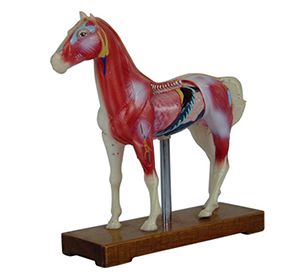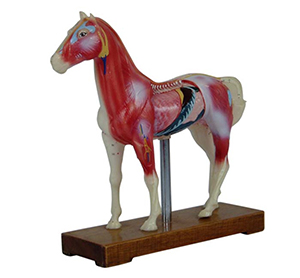ADA MED SUPPLY LIMITED
Phone:+86 19937901373
Tel:+86-0379-65160607
Email:adaanatomy@adaanatomy.com

Article tag: Horse acupuncture model animal acupuncture model

The equine acupuncture model plays an important role in the process of making acupuncture treatment plans for veterinarians, which is reflected in the following aspects:
The precise anatomical design and acupoint labeling provide veterinarians with an accurate reference for the body structure and acupoint distribution of horses. Veterinarians can intuitively observe the structural characteristics of each part of the horse, and understand the exact location of acupuncture points and their relationship with the surrounding tissues. This intuitive display helps veterinarians grasp the condition more accurately and provides a solid anatomical basis for formulating acupuncture treatment plans.

In the traditional acupuncture teaching, there is often a certain disconnect between theory and practice. The emergence of the equine acupuncture model provides a platform for veterinarians to combine theory and practice closely. Veterinarians can simulate the operation on the model, apply the theoretical knowledge of acupuncture to the actual operation, and improve the level of acupuncture skills through repeated practice. This combination of theory and practice helps veterinarians to better understand and master acupuncture treatment techniques, and lays a foundation for the formulation of effective acupuncture treatment programs.
It provides a space for veterinarians to simulate the operation, allowing them to practice and experiment with acupuncture techniques without harming real animals. Through the simulation operation, veterinarians can more accurately grasp the Angle, depth and force of acupuncture parameters, so as to optimize the design of acupuncture treatment. In addition, the model can also help veterinarians simulate the effects of different treatment schemes, evaluate their feasibility and safety, and provide references for the final determination of treatment schemes.
Fourth, improve the therapeutic effect and safety
Acupuncture treatment requires a high degree of professionalism and skill, and improper operation may cause unnecessary injury to the horse. It provides a safe practice platform for veterinarians. Through repeated practice and simulated operation, veterinarians can improve their acupuncture skills and ensure that they can accurately find acupuncture points and control acupuncture strength and depth during treatment. This not only helps to improve the effectiveness of treatment, but also reduces the risk of treatment and keeps the horse safe.
In summary, the equine acupuncture model plays an important role in the process of making acupuncture treatment plans for veterinarians. It not only provides veterinarians with a reference for precise anatomy and acupoint location, but also promotes the integration of theory and practice, optimizes the design of treatment protocols, and improves the efficacy and safety of treatment. With the continuous change of veterinary clinical needs and the continuous progress of science and technology, it will also play a more important role in the future.